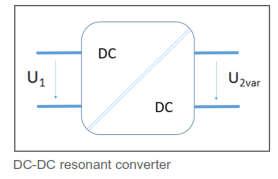International Partner Search
Innovation & Technology Offer
DC-DC resonant converter
Country of Origin: Germany
Reference Number: TODE20200317001
Publication Date: 17 March 2020
Summary
A German university developed a new control method that provides variable output voltages in DC-DC converters. A laboratory model is available. The new resonant converters are characterised by high flexibility and efficiency, small size and low costs. Industrial partners are sought for license agreements.
Description
Flexible chargers for batteries (especially in the field of e-mobility), fuel cell applications or flexible photovoltaic battery combinations all contain switch-mode power supplies with DC converters, DC-DC converters in short. Usually the voltage ratio between output and input voltage of galvanically isolated DC-DC converters can only be varied in the range of 1:2. This is not the case with the new bidirectional, galvanically isolated resonant DC-DC converter offered by a German university: Here the voltage ratio can be variably adjusted in the range 1:4.
With the resonant converter of the German university, the switching load is always balanced to achieve high efficiency. The principle is based on the series-resonant converter: By inserting primary or secondary side freewheels for whole resonant half oscillations, energy is supplied to the resonance circuit or selectively extracted from it, so that various control objectives, in particular a variable output voltage, are achieved. A short-circuit-proof SRC was also presented.
The special feature of the boost and buck-boost modulation method used here for series-resonant converters: Parts of the excitation oscillations are omitted in the input circuit, which allows a lower energy level in the resonant circuit and therefore also a lower voltage at the output circuit (buck operation). If energy is not taken from the output circuit in each period of the oscillation, a higher energy level in the oscillating circuit and therefore a higher output voltage is obtained (boost operation). The resonant converter can be operated bi-directionally with the appropriate circuitry. A method for operating the DC-DC converter was also developed.
The use of this technology is offered here within the framework of a licensing model. This can include a cooperation for further development to market readiness. Industrial partners interested in converter, charger and battery development are sought.

Advantages and Innovations
The bidirectional, resonant converter has several advantages over other converters, especially in terms of efficiency and component size. The decisive advantage, however, is the variable voltage ratio in the range 1:4. This is not the case with conventional solutions.
Further advantages are:
• variable output voltage
• high flexibility and efficiency
• small and light construction
• simpler process
• inexpensive
Stage Of Development
Under development/lab tested
Stage Of Development Comment
A laboratotry model is available. Technology Readiness Level (TRL) 3
Requested partner
The university offers interested companies licenses to the invention and the opportunity to further develop the technology. Potential partners are involved, e.g. in battery production, converters and chargers for e-mobility, fuel cells or renewable energies.
Cooperation offer is closed for requests
